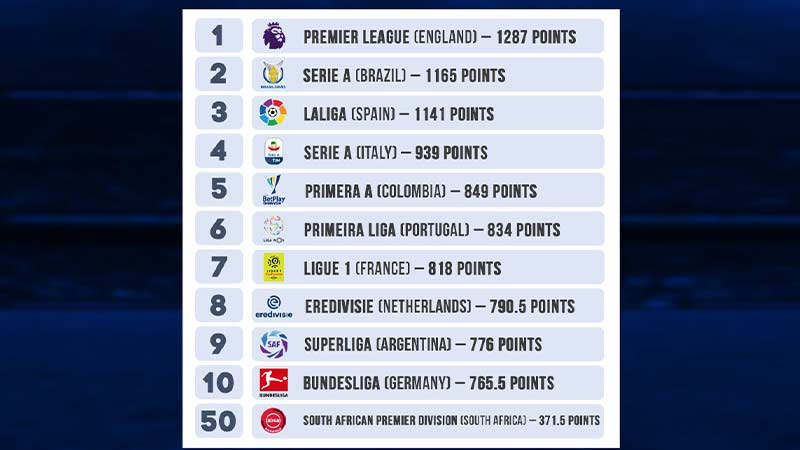Soccer, the world’s most popular sport, enthralls millions with its exciting matches and iconic players. The game’s wealth of statistics, such as Brazil’s 237 victories and Germany’s 130 wins, offers deep insights into team performance, player prowess, and historical trends.
These metrics enhance understanding and enjoyment, aiding fans in predicting outcomes and analyzing strategies.
Key metrics like goals, assists, clean sheets, possession percentages, and pass accuracy, along with advanced stats like expected goals (xG) and player efficiency ratings, provide a deeper appreciation of the game’s intricacies, enriching the soccer experience for all fans.
Whether tracking a team’s defensive reliability through clean sheets or an individual’s creative impact via assists, each statistic brings a new layer of understanding to the sport.
Furthermore, metrics such as expected goals (xG) and player efficiency ratings delve even deeper, offering data-driven insights that highlight underlying performance patterns.
Team Statistics
Understanding team statistics allows you to gain deeper insights into the performance and achievements of soccer teams over time. These statistics cover everything from tournament wins to goals scored in various competitions.
Overview of Team Achievements
Teams with the most World Cup participations include Brazil (21) and Germany (19). Brazil has won five times (1958, 1962, 1970, 1994, 2002), while Germany has secured four titles (1954, 1974, 1990, 2014). Italy also has four wins (1934, 1938, 1982, 2006).
Argentina (1978, 1986) and France (1998, 2018) each have two titles, and Spain has one victory (2010). Other notable wins include Uruguay’s early titles (1930, 1950) and England’s win in 1966. These achievements reflect these teams’ historical impact on the sport.
Team Performance in Major Tournaments
Analyzing team performance in major tournaments like the FIFA World Cup reveals their consistency and dominance. Brazil leads with the most victories (73 wins) and the highest number of World Cup appearances.
Germany is close behind with 67 wins, demonstrating sustained success. Uruguay’s historical attendance records, such as the 1950 World Cup final with 173,850 spectators, underscore the significance of these matches.
South Korea’s continuous participation since 1954 marks their growing influence in global football. Hungary’s record of 540 goals in the 1954 World Cup highlights their attacking prowess.
These statistics reflect the strategic differences and historical progress of teams in highly competitive environments.
Player Statistics
Player statistics in soccer illuminate individual performances and contributions to the game. These metrics help compare players across different eras and competitions.
Career Highlights and Records
Career highlights and records showcase players’ extraordinary achievements. Pelé remains a standout, scoring 77 goals in 92 appearances for Brazil. Dino Zoff, an iconic goalkeeper, set a record by playing 1,142 minutes without conceding a goal in international matches.
Kylian Mbappé stunned the world by scoring four goals in the 2018 FIFA World Cup, becoming one of the youngest to achieve this feat. Essam El-Hadary holds the record as the oldest player to participate in a World Cup match at 45.
Player Performance Comparisons
Player performance comparisons offer insights into their skills and consistency. Lionel Messi and Cristiano Ronaldo often get compared due to their scoring prowess and impact on games. Messi scored 114 goals for Argentina as of 2022.
Ronaldo, with his incredible athleticism, has netted over 115 goals for Portugal. Such comparisons underline the different playing styles and contributions these players bring to their national teams.
Additional Insights
Understanding player statistics helps better appreciate the nuances of soccer. Career records highlight milestones, while performance comparisons provide a deeper look into players’ effectiveness on the field. Use these metrics to gain a richer perspective on soccer dynamics.
Statistical Best XI
In constructing a team of the greatest players by statistical merit, key criteria highlight excellence and consistency in soccer performance. Below are the essential factors and a brief overview of notable best XI teams throughout history.
Criteria for Selection
Selecting players for a statistical Best XI in soccer involves considering several key criteria to ensure a balanced and representative team.
Here are the essential factors typically used:
- Goals Scored: Players with a high goal-scoring record stand out. Forwards and midfielders like Pelé and Lionel Messi, who consistently net goals, are prime candidates.
- Assists Made: The ability to create scoring opportunities is crucial. Playmakers such as Xavi and Kevin De Bruyne, known for their assists, are vital.
- Clean Sheets: Goalkeepers and defenders are judged on their defensive records. Icons like Dino Zoff and Paolo Maldini excel in this area.
- Appearances: Longevity and consistency feature prominently. Players like Ryan Giggs, who boast numerous club and international appearances, are preferred.
- Impact in Major Tournaments: Performances in global competitions like the World Cup enhance a player’s prestige. Kylian Mbappé’s early World Cup success is a notable example.
Notable Best XI Teams Throughout History
Creating a Best XI teams throughout soccer history involves selecting iconic squads known for their achievements and impact on the sport.
Here are some notable Best XI teams from different eras:
- 1950s Hungary Team: Known for their attacking prowess, with Ferenc Puskás leading the charge, this team scored an unmatched 27 goals in the 1954 World Cup.
- 1970s Brazil Team: Featuring Pelé, this team is often cited as the greatest due to their fluid play and World Cup triumphs.
- 1980s Italy Team: With Dino Zoff as the stalwart goalkeeper, Italy’s defensive solidity in this era brought them numerous accolades.
- 1990s Brazil Team: Dominated by Romário and Ronaldo, Brazil’s 1994 and 1998 World Cup performances set high standards.
- 2000s Spain Team: Known for their ‘tiki-taka’ style, Spain, with Xavi and Andrés Iniesta, won consecutive European Championships and a World Cup.
- 2010s Germany Team: This team’s disciplined play, exemplified by Manuel Neuer and Thomas Müller, led to their 2014 World Cup victory.
- Current Era Mixed Team: Combining players like Messi, Cristiano Ronaldo, and Kylian Mbappé, this hypothetical team blends statistical excellence from recent decades.
Key Matches and Tournaments
Key matches and tournaments form the essence of soccer history. These pivotal events shape legacies and elevate the sport to its global stature.
Memorable Matches in Soccer History
Certain matches resonate through time due to their significance and unforgettable moments. The “Maracanazo” in 1950 stands as an iconic upset when Uruguay defeated Brazil 2-1 in the World Cup final.
In 1970, Brazil and Italy clashed in a thrilling World Cup final, with Brazil winning 4-1, showcasing their dominant team led by Pelé. The 1966 World Cup final saw England triumph 4-2 over West Germany, marking England’s only World Cup victory.
The “Match of the Century”, a 1970 World Cup semifinal between Italy and West Germany, ended 4-3 in favor of Italy after extra time—a game full of twists and legendary performances.
Overview of Major Soccer Tournaments
Soccer tournaments provide platforms for nations and players to achieve glory. The FIFA World Cup, held every four years with 32 teams since 1998, is the pinnacle event, with Brazil holding a record five wins.
The UEFA European Championship, featuring 24 teams every four years, and the Copa América, the oldest continental competition, see fierce contests, with Uruguay and Argentina leading in titles. The Africa Cup of Nations, held biennially, sees Egypt with the most titles.
The Asian Cup and CONCACAF Gold Cup are key tournaments in Asia and North America. Each tournament enriches soccer’s tapestry, offering unforgettable moments and fostering intense rivalries.
Trends in Soccer Statistics
Soccer statistics have evolved significantly, influencing how the game is analyzed and played. These trends reveal important insights into player performance and team strategies.
Evolution of Statistical Analysis in Soccer
Since the mid-20th century, statistical analysis in soccer has evolved from simple metrics to complex data models.
Initially reliant on manual record-keeping, the digital age introduced advanced tools like Opta and STATS Perform, offering real-time analytics on player movement, pass accuracy, and defensive actions.
While early metrics focused mainly on goals, by the 2000s, analysis included expected goals (xG), sprint speed, and heat maps. Clubs now employ data analysts to incorporate these statistics into training and match preparation.
How Statistics Influence Modern Soccer
Statistics play a pivotal role in modern soccer, influencing various aspects of the game from strategic planning to player recruitment and fan engagement.
Here’s how statistics impact different facets of the sport:
- Tactical and Strategic Influence: Statistics guide coaches in devising game plans and selecting formations based on opponent analysis, such as adopting high pressing against vulnerable teams.
- Player Scouting and Recruitment: Clubs use statistical metrics like dribbles completed and interceptions to identify players who fit specific tactical roles and team needs.
- Fan Engagement and Predictive Analysis: Soccer statistics enrich fan experiences by providing comprehensive insights into player and team performances, enabling predictive analysis and informed discussions.
- Data-Driven Decisions: In modern soccer, data-driven insights inform strategic decisions across player development, scouting, and match tactics, enhancing overall performance and competitiveness.
Frequently Asked Questions
How have soccer statistics evolved over the years?
Soccer statistics have evolved from simple metrics like goals and assists to complex data models that analyze possession, player movements, and real-time game dynamics.
What advanced tools are used for soccer statistics?
Tools such as Opta and STATS Perform are used for real-time analytics and data collection in modern soccer.
How do soccer statistics influence team strategies?
Coaches use statistical data for designing game plans, formations, and in-game tactics to maximize team performance.
Why are statistics important in player scouting?
Clubs analyze performance metrics to identify talent and assess a player’s potential fit within the team.
Can fans use soccer statistics to predict game outcomes?
Yes, fans often interact with soccer statistics to predict match outcomes and enhance their understanding of the game.
Conclusion
Understanding soccer statistics is essential for anyone passionate about the game. These metrics aren’t just numbers; they reveal the underlying strategies and performances that shape each match.
By leveraging tools like Opta and STATS Perform, you gain real-time insights that can transform how you view and analyze soccer. Whether you’re a coach, player, or fan, embracing data-driven decisions allows you to appreciate the sport’s complexities.
Dive into the world of soccer statistics and enhance your knowledge of the beautiful game. Dive into the world of soccer statistics and enhance your knowledge of the beautiful game.
Key metrics to focus on include possession percentage, pass accuracy, shots on target, and expected goals (xG). These statistics not only highlight individual and team performance but also help you predict future outcomes and identify areas for improvement.
Stay updated with the latest insights to make informed opinions and enjoy every match with a deeper understanding.








Brice Petersen